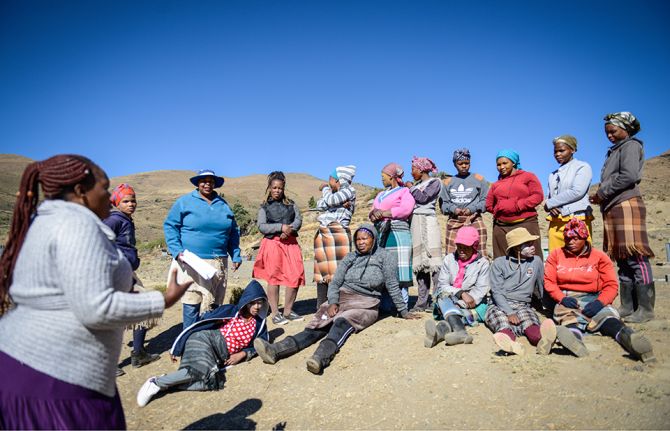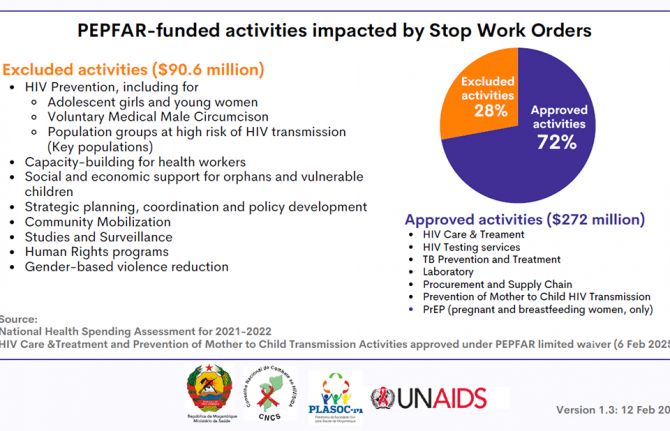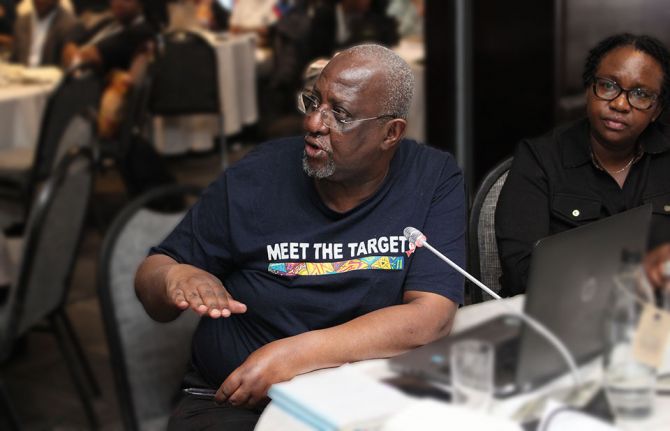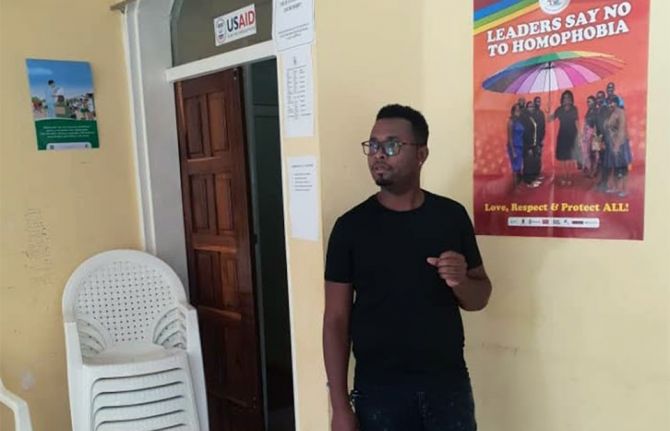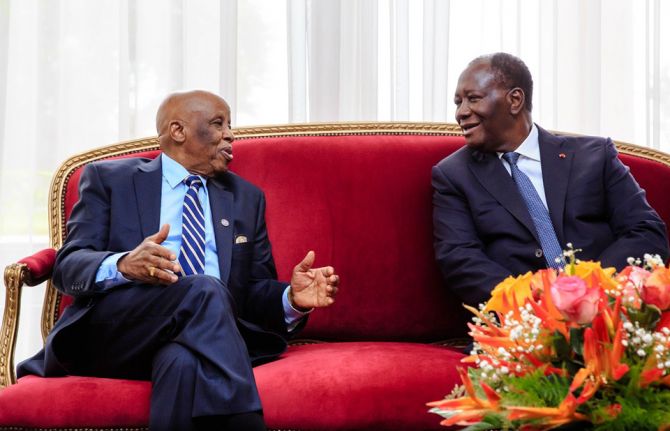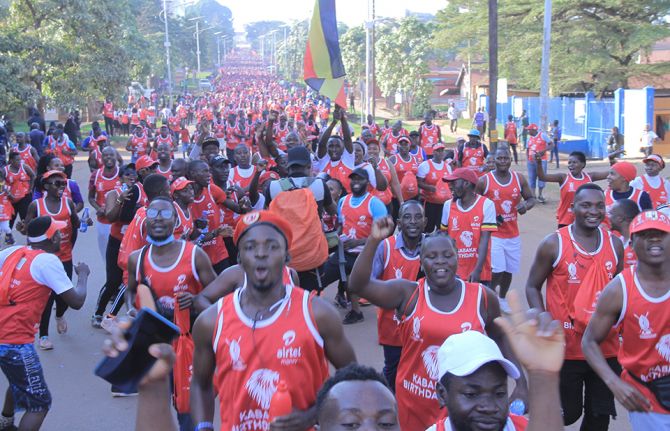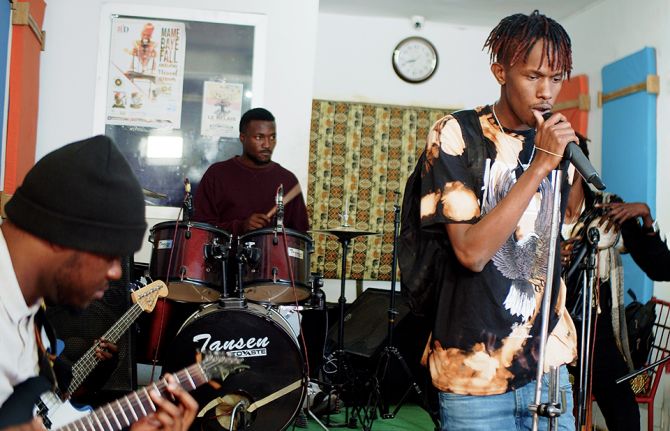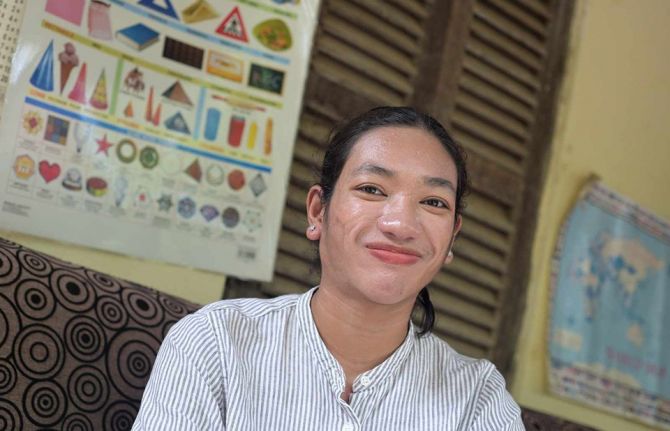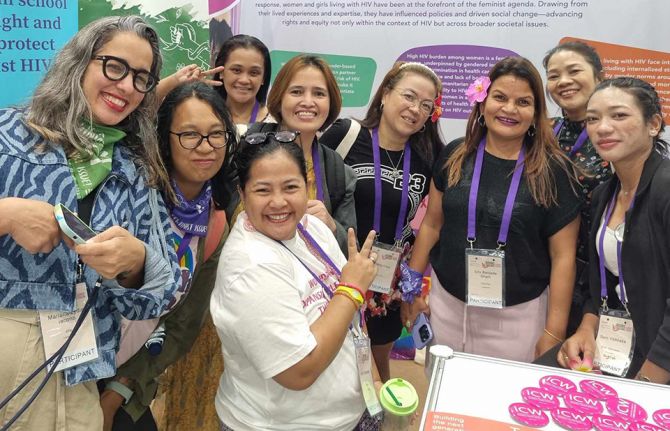
Feature Story
Faith-based action: Confronting the impact of HIV funding cutbacks
08 June 2011
08 June 2011 08 June 2011
Credit: Caritas
A High Level Meeting side event called Faith-based action to achieve universal access: Confronting the impact of funding cutbacks and advocating for the special needs of mothers and children living with HIV was held on 8 June. It was sponsored by Catholic HIV/AIDS Network (CHAN), Caritas Internationalis (CI), and Catholic Medical Mission Board (CMMB).
Becky Johnson of the Ecumenical Advocacy Alliance presented recent research conducted among 11 members of the CHAN documenting the effects of flat lining of funding on Catholic health service delivery partners. The position paper includes analysis of impact of funding cuts on HIV responses in medical programmes. Concerned about meeting universal access targets, the paper includes a call to governments that donors maintain their long-term funding commitments to ensure the continuation of current HIV treatment programmes, as well as new programmes where needed and for health infrastructure.
It also recommends the provision of comprehensive and integrated prevention, treatment, care and support for adults and children living with or vulnerable to HIV infection. It identifies a need to build, strengthen and sustain human resource capacity to carry out comprehensive programmes through training and retention of skilled staff and volunteers.
Its third recommendation focuses on children. It calls for improved access to paediatric testing and child friendly treatment for HIV and HIV/TB co-infection; prevention of vertical transmission; and continued support for orphans and vulnerable children.
AIDS has brought to our attention the need to bridge health services with the broader issues of human rights, and social justice to address the root causes of vulnerability
Dr Paul De Lay, UNAIDS Deputy Executive Director, Programme
UNAIDS Deputy Executive Director, Programme, Paul De Lay was an invited speaker at the event. Dr De Lay challenged the participants to think about what we really mean by “universal access”. He drew attention to the fact that AIDS brought together the medical community with the populations most affected by the disease, for the first time in the history of public health. "AIDS has brought to our attention the need to bridge health services with the broader issues of human rights, and social justice to address the root causes of vulnerability," Dr De Lay said.
Msgr Vitillo, Caritas Internationalis Special adviser on HIV/AIDS, made a strong plea for greater investment in the development of child friendly medications for HIV and the difficulties faced by mothers when asked to split adult tablets into six pieces for their children.
The event was moderated by Ms Finola Finnan, Trócaire and Chair of Catholic HIV and AIDS Network and Mr Jack Galbraith, President and CEO, Catholic Medical Mission Board.
UN General Assembly High Level Meeting on AIDS
Thirty years into the AIDS epidemic, and 10 years since the landmark UN General Assembly Special Session on HIV/AIDS, the world has come together to review progress and chart the future course of the global AIDS response at the 2011 UN General Assembly High Level Meeting on AIDS from 8–10 June 2011 in New York. Member States are expected to adopt a new Declaration that will reaffirm current commitments and commit to actions to guide and sustain the global AIDS response.
External links
External links

Feature Story
International Advisory Group convenes to rally solidarity for universal access to HIV services
08 June 2011
08 June 2011 08 June 2011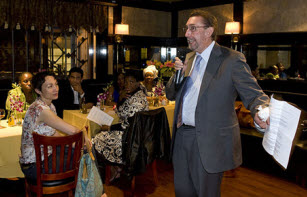
UNAIDS Deputy Executive Director, Programme, Paul De Lay and South Africa’s Minister of Social Development Bathabile Dlamini addresses an IAG Connector Event in New York, 07 June 2011.
Credit: UNAIDS/J. Szenes
The International Advisory Group (IAG) on universal access to HIV prevention, treatment, care and support which is made up of a diverse group of HIV experts from various sectors, convened together in New York on 7 June on the eve of the UN General Assembly High Level Meeting on AIDS.
Hosted by its co-chairs Bathabile Dlamini, Minister of Social Development, Republic of South Africa and Paul De Lay, UNAIDS Deputy Executive Director, Programme, the event is follow-up action to the IAG’s recently held meeting in Johannesburg which culminated in a bold and strong consensus statement on the need for global solidarity for universal access.
The IAG’s consensus statement identified key priorities to change the trajectory of the HIV epidemic, save lives and contribute towards achieving the UNAIDS vision of zero new HIV infections, zero discrimination and zero AIDS-related deaths. The consultation was an opportunity for the advisory group to discuss it has been leveraged by IAG members and various organizations in preparing for the High Level Meeting.
We urge IAG members to use this experience to influence the regional and country responses to HIV and AIDS in the future
Bathabile Dlamini, Minister of Social Development, Republic of South Africa
“We urge IAG members to use this experience to influence the regional and country responses to HIV and AIDS in the future,” said Ms Dlamini who suggested that the IAG members to take a leadership role in implementing the outcomes of the High Level Meeting. “It will be important the resolutions take are put into action plans by countries.”
Echoing Ms Dlamini, Dr De Lay said, “The work of the IAG is not finished at this High Level Meeting. In fact, it is just beginning—with each IAG member: as you take the message into the foras where it needs to be heard."
The IAG is mandated by the UNAIDS’ governing body the Programme Coordination Board to review the findings of countries’ and regions’ universal access consultations as well as other global and regional studies and declarations, and advice on the way forward for the global AIDS response.
UN General Assembly High Level Meeting on AIDS
The work of the IAG is not finished at this High Level Meeting. In fact, it is just beginning—with each IAG member: as you take the message into the foras where it needs to be heard.
Paul De Lay, Deputy Executive Director, Programme
Thirty years into the AIDS epidemic, and 10 years since the landmark UN General Assembly Special Session on HIV/AIDS, the world has come together to review progress and chart the future course of the global AIDS response at the 2011 UN General Assembly High Level Meeting on AIDS from 8–10 June 2011 in New York. Member States are expected to adopt a new Declaration that will reaffirm current commitments and commit to actions to guide and sustain the global AIDS response.
External links
External links
Publications
Publications

Feature Story
UN Plus members discuss stigma and health insurance with UN Secretary-General during 2011 High Level Meeting on AIDS
08 June 2011
08 June 2011 08 June 2011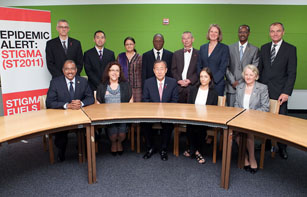
UN Plus meeting with the Secretary-General Ban Ki-Moon and UNAIDS Cosponsor Executive Heads at UN Headquarters on 8 June 2011.
Credit: UNAIDS/B. Hamilton
UN Plus, the United Nations group of HIV positive employees, met with the UN Secretary-General Ban Ki-moon on 8 June to discuss stigma and discrimination as well as the various health insurances existing in the different UN agencies that are hampering the access of staff members living with HIV, and their families, to continued, comprehensive care.
“I am very committed to issues that UN Plus advocates and whenever I meet with its members I am personally motivated to take action against such issues as stigma and discrimination,” said UN Secretary-General Ban Ki-moon. “I reiterate the UN’s commitment to continue to collaborate with UN Plus to improve the work environment for UN staff living with HIV,” he added.
The meeting was an opportunity for UN Plus coordinator John Oshima to give an update on the work of the UN system-wide advocacy group. Since its last meeting with the UN Secretary-General in 2009, UN Plus has grown from 165 members to 220. Approximately 70% of its members are women and the majority of them are staff members working in sub-Saharan Africa. UN Plus is currently focusing efforts on reaching out to more staff living with HIV in other regions including Asia, the Caribbean and Latin America.
UN Plus organizes activities across the UN system to support UN staff living with HIV and their family members globally. These activities include advocacy to promote better access to care and support, removing stigma from the workplace, ensuring confidentiality, and lifting entry and travel restrictions for people living with HIV.
I reiterate the UN’s commitment to continue to collaborate with UN Plus to improve the work environment for UN staff living with HIV
UN Secretary-General Ban Ki-moon
Martina Clark from UNICEF talked about access to care and health insurance among HIV-positive staff members. She briefed the Secretary-General on the fact-finding exercise that UN Plus is conducting to identify gaps in health insurance schemes adopted by different agencies as well as several proactive initiatives by a number of agencies to lessen financial burdens caused by costly treatments.
Jacqueline Cortes from UNAIDS in Brazil briefed the Secretary-General on stigma and discrimination at workplace with her own experience and introduced a new campaign co-produced with UN Cares titled Stigma Fuels HIV which is hoped will lead to behaviour change among UN staff members and end HIV-related stigma and discrimination.
Mr Ban said that it is the duty of all Heads of Agency to speak out and act against discriminatory or stigmatizing behaviour at any level. This includes working towards equitable and fair access to health care services for people living with HIV and those with other long-term chronic conditions. In addition, Mr ban said that a person’s HIV status should not adversely impact his or her career progression and that HIV positive staff should have the same opportunities as anyone else.
The UNAIDS Executive Director closed the meeting thanking the Secretary-General, Cosponsor Executives, and UN Plus representatives. Mr Sidibé restated his personal commitment to the importance of the UN in providing an enabling environment for staff living with HIV.
UN General Assembly High Level Meeting on AIDS
Thirty years into the AIDS epidemic, and 10 years since the landmark UN General Assembly Special Session on HIV/AIDS, the world has come together to review progress and chart the future course of the global AIDS response at the 2011 UN General Assembly High Level Meeting on AIDS from 8–10 June 2011 in New York. Member States are expected to adopt a new Declaration that will reaffirm current commitments and commit to actions to guide and sustain the global AIDS response.
External Links
Related
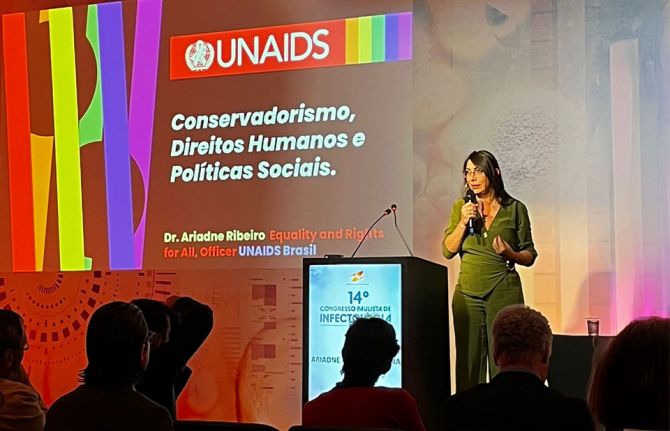 Upholding dignity for everyone: Ariadne Ribeiro Ferreira
Upholding dignity for everyone: Ariadne Ribeiro Ferreira

21 November 2024
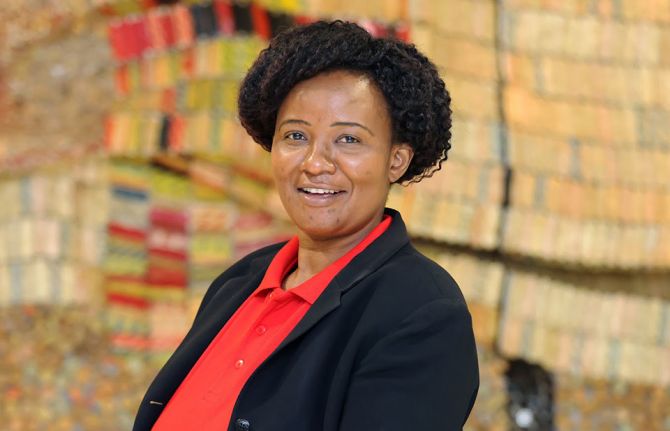 Evelyn Siula: A journey of strength and solidarity
Evelyn Siula: A journey of strength and solidarity
18 November 2024

Feature Story
HIV prevention and protection for women and girls cannot wait
08 June 2011
08 June 2011 08 June 2011
Credit: Women Deliver
The International Peace Institute, in collaboration with the Permanent Mission of Norway to the United Nations, Women Deliver, and Family Care International, hosted a policy forum entitled Prevention and Protection Save Lives: Girls, Women, and HIV on the sidelines of the 2011 UN General Assembly High Level Meeting on AIDS on 8 June.
HIV is now recognized as the leading cause of death among women of reproductive age, the forum aimed to identify and strengthen the response to HIV and raise awareness about the interconnectedness of women’s health issue in relation to the broader development agenda.
In this light the high level panel brought together Michelle Bachelet, Executive Director, UN Women; Purnima Mane, Deputy Executive Director (Programs), UNFPA; Carmen Barroso, Regional Director, IPPF/WHR; Jan Beagle Deputy Executive Director, Management and External Relations, UNAIDS; and Ms Lindsay Menard-Freeman programme officer at Global Youth Coalition on HIV/AIDS to discuss lessons learned, current challenges, and the path forward.
“Young people are now the actors, mobilising for prevention, taking ownership of the AIDS response and shaping the attitudes of future leaders,” said UNAIDS International Goodwill Ambassadors Her Royal Highness the Crown Princess of Norway Mette-Marit who opened the forum. “We have to make sure that the next wave of leadership is equipped, engaged and sufficiently supported to maintain and develop the response.”
Also participating in the discussion was UNAIDS International Goodwill Ambassador Annie Lennox, a strong women’s rights activist: “We have the knowledge, we have the treatment,” said Ms Annie Lennox and urged world leaders gathering at the High Level Meeting on AIDS to take action on women and girls: “This is our moment: Don’t let us down.”
The Executive Director of UN Women called for leadership on this: “We know what has to be done and we know what works. And we can do better to stop this epidemic. With political will we can create the fiscal space to make women and girls a priority,” said Ms Bachelet.
The discussion, moderated by James Chau, Goodwill Ambassador, UNAIDS and a journalist with China CCTV, highlighted that young women in particular are vulnerable to HIV. As a result of a combination of biological and socio-cultural factors, nearly a quarter of all new global HIV infections are among young women aged 15-24.
We have the knowledge, we have the treatment. This is our moment: Don’t let us down
Annie Lennox, UNAIDS International Goodwill Ambassador
“Knowing your epidemic” in gender terms is critical. The human rights, including the sexual and reproductive rights of all women and girls – in particular women and girls living with HIV – must be protected and promoted in all HIV and global health programmes.”
However, progress has been made. More than 60 countries have shown their commitment to gender equality by implementing the UNAIDS Agenda for Women and Girls and HIV, engaging over 400 civil society organizations.
“It’s important to remember that young people are actors, and young people are asking for what they need,” said Ms Menard-Freeman. “Now that we are here [at the High Level Meeting on AIDS], we need the voices of young people to be heard.”
One of the critical examples raised as a model for a consolidated approach to women’s health was the United Nation’s Every Woman Every Child campaign. The campaign, launched during the United Nations Millennium Development Goals Summit, has so far seen a US$ 40 billion commitment by countries to improve the health of women and children. If implemented, it is estimated that the strategy could save up to 10 million lives of women and children by 2015.
The new UNAIDS Strategy 2011 - 2015: Getting to Zero has made advancing human rights and gender equality for the HIV response one of its three key strategic directions, and is committed to ensure that the rights of women and girls in the context of HIV.
UN General Assembly High Level Meeting on AIDS
Thirty years into the AIDS epidemic, and 10 years since the landmark UN General Assembly Special Session on HIV/AIDS, the world has come together to review progress and chart the future course of the global AIDS response at the 2011 UN General Assembly High Level Meeting on AIDS from 8–10 June 2011 in New York. Member States are expected to adopt a new Declaration that will reaffirm current commitments and commit to actions to guide and sustain the global AIDS response.
External links
Related
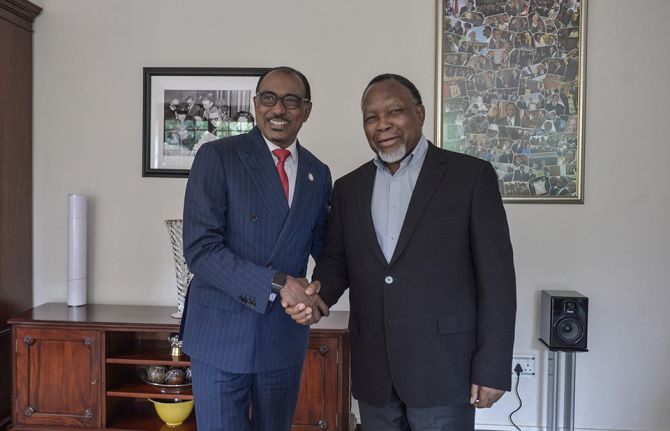 Keeping up the momentum in the global AIDS response
Keeping up the momentum in the global AIDS response

24 April 2019
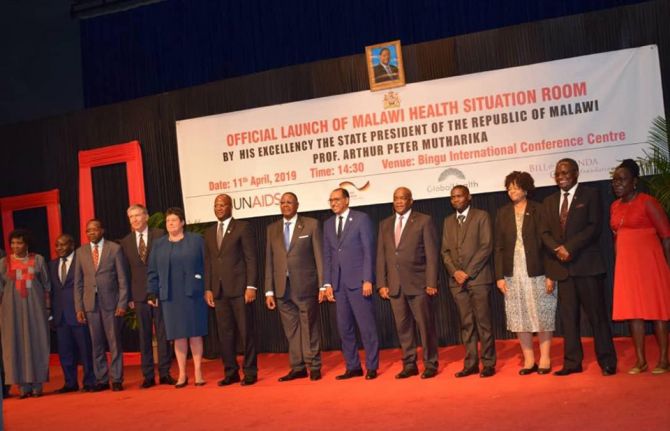 Malawi launches its health situation room
Malawi launches its health situation room

12 April 2019
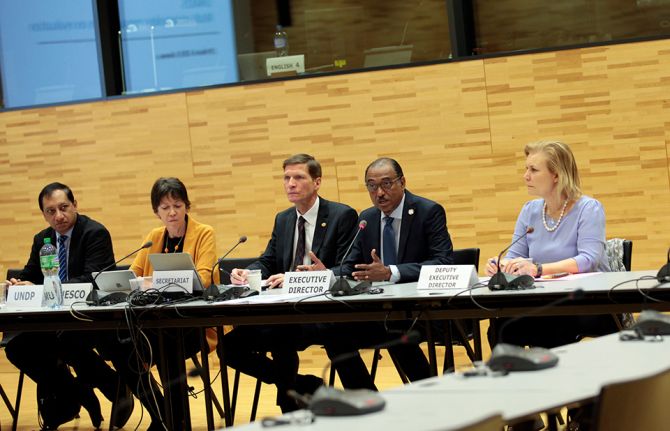 Learning lessons on evaluation
Learning lessons on evaluation

02 April 2019

Press Release
World leaders renew commitment to AIDS, health and sustainable development
08 June 2011 08 June 2011
(Left to Right): United Nations Secretary-General Ban Ki-moon, President of Rwanda Paul Kagame, United States Global AIDS Coordinator Ambassador Eric Goosby, President of the General Assembly Joseph Deiss at the Heads of State event - AIDS, Health, and Development, held at UN Headquarters, NYC, on June 8, 2011
Credit: UNAIDS/B.Hamilton
NEW YORK/GENEVA, 8 June 2011—More than 20 Heads of State and Government have come together at a special event focusing on leadership, cooperation and country ownership in the response to HIV. The event, attended by close to 400 people, was held during the United Nations General Assembly High Level Meeting on AIDS to renew commitment and identify opportunities in scaling up the HIV response, improving health and achieving the 2015 Millennium Development Goals.
The President of Rwanda, Paul Kagame, hosted the debate which outlined ways of accelerating action to help countries move closer towards universal access to HIV prevention, treatment, care and support.
He outlined three main areas as key to the success of the AIDS response: leadership, ownership and collaboration. “Not a single country, not a single individual, business or entity can win this struggle alone,” he said. “Once the leadership and commitment is there in any country and any community, results begin to show.”
The need to increase access to services for people most vulnerable to HIV and respect for human rights was central to the discussions. Strong and visionary leadership combined with commitment and global solidarity around HIV were underlined as essential to moving the response forward.
“We can bring HIV deaths and new HIV infections to zero,” said United Nations Secretary-General Ban Ki-moon. “Our targets may seem ambitious but they are achievable if we are united.”
Leaders at the event also looked to the future of the HIV response and the importance of investing in youth as the leaders of tomorrow and encouraging their full engagement in the AIDS response.
“If we want to transform the response, we have to bring a new agenda for the future,” said Michel Sidibé, Executive Director of the Joint United Nations Programme on HIV/AIDS (UNAIDS). “This will only be achieved if we engage young people to lead a new social movement around AIDS and ensure a sustainable response.”
The speakers stressed the need to overcome the challenges to sustainable and predictable financing. In a report launched ahead of the High Level Meeting on AIDS, UNAIDS outlined that US$ 22 billion will be needed by 2015 to halve new HIV infections and expand access to HIV treatment. However, the report also revealed that international funding for HIV had declined from 2009 to 2010.
“What we need is resources, best policy, and law to ensure and protect the rights of people living with HIV,” said Ms Anandi Yuvuarj, Regional Coordinator of the International Community of Women Living with HIV. “Everyone must have access to HIV prevention, treatment, care and support, particularly people most vulnerable to HIV.”
Speakers emphasized the need for systematic improvement of the efficiency and effectiveness of existing AIDS and health spending, as well as the importance of ensuring the best value for money through effective and efficient HIV programming. In addition, they discussed the need for countries to look for new streams of revenue from domestic, regional and international sources.
Success in South-South cooperation efforts were discussed as an effective way of finding new paradigms of development and sharing innovation within regions for an accelerated response to HIV.
Leaders attending the event pledged to increase efforts to improve the effectiveness, efficiency and sustainability of their national AIDS responses to accelerate progress towards achieving universal access to HIV prevention, treatment, care and support services.
Press centre
Download the printable version (PDF)

Feature Story
Getting to Zero new HIV infections: High Level Meeting panel outlines way forward
08 June 2011
08 June 2011 08 June 2011
Ms Mari-Josee Jacobs, Minister or Cooperation and Humanitarian Affairs, Luxemburg, Moderator Ms Kgomotso Matsunzane, Dr Jarbas Barbosa, Deputy Minister of Health of Brazil, Helen Clark, United Nations Development Programme, and Jaevion Nelson, youth activist from Jamaica.
Photo : Photo ONU/Eskinder Debebe
Global rates of new HIV infections have steadily declined over the past years, with the annual rate falling by nearly 25% between 2001 and 2009. But with 7 000 new HIV infections daily, the rate of people becoming newly infected still outpaces the capacity to extend treatment access and cope with the effects of HIV.
As part of the United Nations General Assembly High Level Meeting on AIDS, a panel entitled Prevention—what can be done to get to Zero new infections? chaired by Ms Mari-Josee Jacobs, Minister or Cooperation and Humanitarian Affairs, Luxemburg, brought together the Administrator of the United Nations Development Programme (UNDP), Helen Clark, Jaevion Nelson, youth activist from Jamaica, and Dr Jarbas Barbosa, Deputy Minister of Health of Brazil engaged with the audience in an inspired and interactive session on how to amplify and sustain the momentum of this HIV prevention revolution.
Setting the scene, Ms Jacobs opened with stressing the importance on involving people living with HIV in all aspects of HIV prevention programming: “It is important to engage people living with HIV—and especially young people living with HIV—in HIV prevention efforts to improve programmes with full respect for human rights to all.”
Moderated by South African TV personality Kgomotso Matsunzane, the discussion centred around key questions such as ‘What stands in the way of getting to zero new infections?’ and ‘How are rights integral to prevention?’
We need address the punitive laws that act as barriers to HIV prevention. The law can stand in the way or promote effective responses—we must create an enabling legal environment for HIV prevention.
Helen Clark, Administrator of the United Nations Development Programme
“With this High Level Meeting we have a unique opportunity,” said Dr Barbosa as he opened the panel discussion. “We cannot wait for another 30 years to eliminate HIV. We need a strong declaration from this High Level Meeting that represents the political commitment, and that moves the agenda forward.”
According to the most recent population-based surveys in low- and middle-income countries, only 24% of young women and 36% of young men responded correctly when asked five questions on HIV prevention as well as misconceptions about HIV transmission. And while global new HIV infections are decreasing, Eastern Europe and Central Asia is the only region in the world where new HIV infections are increasing.
In her opening address Ms Helen Clark, UNDP Administrator noted that there is a need to confront the social, sexual and gender norms that drive vulnerability to HIV.
“Legal frameworks need to accommodate effective responses to HIV. So often the law stands in the way of reducing risk and vulnerability, and of spreading access to treatment and prevention services. Where human rights are not upheld, genuine universal access to services is impossible,” said Ms Clarke.
Jaevion Nelson, youth activist from Jamaica, agreed: “Far too many programmes are failing because they are not based on the evidence that exists. We must all: as governments, as civil society and the international community do the right thing.”
HIV prevention investments only represent about 22% of all HIV spending in 106 low- and middle-income countries. Clearly much remains to be achieved to ensure that the vision of zero new HIV infections is reached.
In an impassioned intervention from the floor, Dr Nafsiah Mboy Executive Director of the Indonesian National AIDS Commission urged the panellists to remember to address a group who are commonly not considered most at risk, but indeed are—the ‘4 M’s’ as she called them—mobile men with money in a ‘macho’ environment. “Let us turn these men into responsible men. That way we will have zero new infections among our women and zero new infections among our children,” said Dr Mboy.
Far too many programmes are failing because they are not based on the evidence that exists. We must all as governments, as civil society and the international community to do the right thing.
Jaevion Nelson, the youth activist from Jamaica
It was also agreed in the discussion that rapid access to both future and existing HIV prevention tools—including male and female condoms, male circumcision, the elimination of vertical transmission and treatment for prevention—is needed. The last point inspired by the recent announcements of the HPTN 052 study which showed that if an HIV-positive person adheres to an effective antiretroviral therapy regimen, the risk of transmitting the virus to their uninfected sexual partner can be reduced by 96%.
UNAIDS strategy 2011 – 2015: Getting to Zero outlines the bold goals for 2015: 1) sexual transmission of HIV reduced by half, including among young people, men who have sex with men and transmission in the context of sex work; 2) Vertical transmission of HIV eliminated and AIDS-related maternal mortality reduced by half; and 3) all new HIV infections prevented among people who use drugs. This is part of UNAIDS vision to reach zero new HIV infections.
UN General Assembly High Level Meeting on AIDS
Thirty years into the AIDS epidemic, and 10 years since the landmark UN General Assembly Special Session on HIV/AIDS, the world has come together to review progress and chart the future course of the global AIDS response at the 2011 UN General Assembly High Level Meeting on AIDS from 8–10 June 2011 in New York. Member States are expected to adopt a new Declaration that will reaffirm current commitments and commit to actions to guide and sustain the global AIDS response.
External Links
External Links
Multimedia
Multimedia
Publications
Publications
Related
 Keeping up the momentum in the global AIDS response
Keeping up the momentum in the global AIDS response

24 April 2019
 Malawi launches its health situation room
Malawi launches its health situation room

12 April 2019
 Learning lessons on evaluation
Learning lessons on evaluation

02 April 2019

Feature Story
Shared responsibility – a new global compact for HIV
08 June 2011
08 June 2011 08 June 2011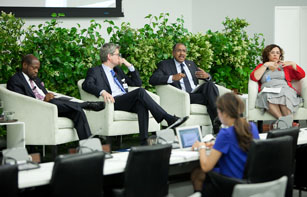
L to R: Honourable Denzil Llewellyn Douglas, Prime Minister of the Federation of St Kitts & Nevis, Mr Søren Pind Minister for Refugees, Immigration and Integration and Minister of Development Cooperation of Denmark, UNAIDS Executive Director Michel Sidibé, and the General Secretary of the National Confederation of Municipal Workers in Brazil (Central Única dos Trabalhadores) and inter-American Regional co-President for Public Services International Ms Juneia Batista.
Credit: UNAIDS/B.Hamilton
A call for a new global deal of compacts to shift leadership of the AIDS response to countries was made in the first panel Shared responsibility–a new global compact for HIV on the opening day of the UN General Assembly High Level Meeting on AIDS.
Chaired by the Honourable Denzil Llewellyn Douglas, Prime Minister of the Federation of St Kitts & Nevis, the panel brought together the UNAIDS Executive Director Michel Sidibé, Mr Søren Pind Minister for Refugees, Immigration and Integration and Minister of Development Cooperation of Denmark, and the General Secretary of the National Confederation of Municipal Workers in Brazil (Central Única dos Trabalhadores) and inter-American Regional co-President for Public Services International Ms Juneia Batista.
Shared responsibility needed
Against the backdrop of the global financial crisis, , the panel pprovided a unique opportunity to build consensus on a new global agreement for the AIDS response that could serve as a pathfinder to a new deal of shared but differentiated responsibility for health and development.
“Shared responsibility is not an option for small states. It is our reality. We have no choice in the Caribbean but to develop shared approaches in all sectors.”
Honourable Denzil Llewellyn Douglas, Prime Minister of the Federation of St Kitts & Nevis
“Small is beautiful. And different,” said Hon Douglas sharing his experiences from the island Federation of St Kitts & Nevis “Shared responsibility is not an option for small states. It is our reality. We have no choice in the Caribbean but to develop shared approaches in all sectors.”
Despite the increasing clout of emerging political powers and strong economic growth in many African countries, many national responses to HIV in low- and middle-income countries remain fragile, are largely externally-funded and driven by external development agendas. In 56 countries, international donors supply at least 70% of HIV resources.
Shared values for shared responsibility
Emphasizing the need for mutual respect and understanding in development cooperation Mr Pind encouraged participants to be truthful and work together. “But there are certain principles that you cannot ignore. Like discrimination against populations at higher risk. And this needs to be said,” he noted.
According to the panel, country ownership and sustainability will require increased and predictable long-term domestic and international funding. “Don’t get me wrong, I am all for innovative financing. But certain donors can not hide behind the need for innovative financing to shy away from meeting their commitments on official development assistance,” said Mr Pind.
At the same time, governments must be accountable for increasing domestic investment where possible and allocating resources where they are most needed and putting in place an enabling environment said the panel.
“10 years ago we would not have had this debate. The world has changed completely and we have to reflect on this. It is time to think about a new paradigm of partnership based on share responsibility,” said Mr Sidibé. “And we need share responsibility based on shared values for a social compact.”
Panellists and audience alike discussed priorities such as assuring continued leadership and shared responsibility for the AIDS response, including a new generation of leadership; strengthening broad national ownership and engaging communities in order to foster local and sustainable solutions; securing long-term financing; and increasing efficiency and ensuring mutual accountability for the future global response. Importantly, as noted by Ms Batista: “Shared responsibility and intelligent investment does not mean that countries should in any way adjust in reaching their commitments.”
10 years ago we would not have had this debate. The world has changed completely and we have to reflect on this. It is time to think about a new paradigm of partnership based on share responsibility
Michel Sidibé, UNAIDS Executive Director
Outlines of a new global compact
In this light, the new global compact discussed in the panel can be formulated around three key pillars. The country’s responsibility, the international community’s responsibility and the shared responsibility for innovation:
The Country responsibility
- ensuring voice and participation in democratic governance
- delivering smart responses—including enabling environments and human rights
- increased domestic investment on basis of ability
International responsibility
- responsible ‘donorship’—including long-term predictable and aligned financing
- increased support from emerging countries and new development partners
- more coherent international policy on trade, regulation, etc
Shared responsibility for innovation
- innovative financing mechanisms—including the private sector
- innovative partnerships including South-South cooperation and triangular cooperation
- enhanced mutual accountability for the reciprocal responsibility in the compacts including joint planning and reviews of the smart responses
According to the participants, universal access to HIV prevention, treatment, care and support can be achieved by spending smartly and increasing annual investment to between US$ 22 and 24 billion by 2015. These resources can be mobilized by diversifying funding sources and balancing responsibilities.
UN General Assembly High Level Meeting on AIDS
Thirty years into the AIDS epidemic, and 10 years since the landmark UN General Assembly Special Session on HIV/AIDS, the world has come together to review progress and chart the future course of the global AIDS response at the 2011 UN General Assembly High Level Meeting on AIDS from 8–10 June 2011 in New York. Member States are expected to adopt a new Declaration that will reaffirm current commitments and commit to actions to guide and sustain the global AIDS response.
External Links
External Links
Multimedia
Multimedia
Publications
Publications
Related
 Keeping up the momentum in the global AIDS response
Keeping up the momentum in the global AIDS response

24 April 2019
 Malawi launches its health situation room
Malawi launches its health situation room

12 April 2019
 Learning lessons on evaluation
Learning lessons on evaluation

02 April 2019

Press Release
Future of AIDS response focus of UN General Assembly High Level Meeting
07 June 2011 07 June 2011Principal actors in the AIDS movement join world leaders at critical crossroads

(Left to Right): Interpreter; Tetyana Afanasiadi, Human Rights and Community Activist; Paul De Lay, UNAIDS Deputy Executive Director, Programmes; Joseph Deiss, President of the UN General Assembly; Jean-Victor Nkolo, Spokesperson, UN General Assembly President at Opening Press Conference on June 7, 2011 at UN Headquarters, NYC. Credit: UNAIDS/B.Hamilton
NEW YORK, 7 June 2011—More than 3000 people will come together at the United Nations in New York tomorrow for the UN General Assembly High Level Meeting on AIDS. The meeting, which runs from 8-10 June, will provide an opportunity to take stock of the progress and challenges of the last 30 years and shape the future AIDS response.
The High Level Meeting on AIDS is taking place 10 years after the historic 2001 United Nations Special Session on HIV/AIDS, and the 2006 signing of the Political Declaration where UN Member States committed to moving towards universal access to HIV prevention, treatment, care and support. More than 30 Heads of State, Government and Vice Presidents are expected to attend the meeting which will include official plenary and five panel sessions along with 40 individual side events. On the final day of the High Level Meeting on AIDS, UN Member States are expected to adopt a declaration which will guide country responses to HIV over the next five years.
The opening and closing plenary sessions will be presided over by Joseph Deiss, President of the United Nations General Assembly. He said, “The momentum around this meeting is unprecedented and promises to make this an historic event. We are looking to UN Member States to make bold commitments which will help us reach our shared goal of zero new HIV infections, zero discrimination and zero AIDS-related deaths.”
Although some countries are still struggling to reach their universal access targets, many have made significant strides in responding to their epidemics. Twenty-two countries have achieved universal access to services which prevent mother-to-child transmission of HIV.
As well as country-led successes, considerable progress has been made in the global response to HIV since the 2001 UN Special Session on HIV/AIDS. The rate of new HIV infections has decreased by 25% in the last 10 years, deaths have reduced by 20% in the last 5 years and 6.6 million people are now accessing antiretroviral therapy, compared to just a few thousand in 2001. Progress has also been made in breaking down barriers to stigma and discrimination and in removing punitive laws such as travel restrictions for people living with HIV.
“Inequity, discrimination and laws against people living with or at risk of HIV continue to block access to HIV services for people most in need,” said Michel Sidibé, Executive Director of the Joint United Nations Programme on HIV/AIDS (UNAIDS). “We need a response to HIV that is grounded in human rights and one which promotes equality and equity. Achieving this will open the way to a world free from HIV.”
UNAIDS recently reported that despite successes in HIV prevention and treatment, more people than ever before were living with the virus, 34 million according to latest estimates. They also reported that international funding for AIDS had declined.
“If resources go down—people most in need will suffer,” said Tetyana Afanasiadi, Human Rights activist from Ukraine. "The lives of millions of people directly depend on the resources allocated. Today I am alive thanks to antiretroviral therapy and opioid substitution therapy which I had access to through prevention and support programmes. Reducing of the resources allocated to those programs is a direct threat for me and for millions of people around the world."
The High Level Meeting on AIDS is taking place from the 8-10 June at the United Nations in New York. It will bring together UN Member States, International Organisations, Civil Society, people living with HIV and public and private sector partners.
For more information and to see the full program and access feature stories, webcasts, videos, media information and related documents please visit the official website at: http://www.un.org/en/ga/aidsmeeting2011/
Contact
UNAIDS GenevaSophie Barton-Knott
tel. +41 22 791 1697
bartonknotts@unaids.org
UNDPI
Vikram Sura
tel. +1 212 963 274
sura@un.org
Multimedia
Multimedia

Feature Story
Poster power: A collection of AIDS awareness campaigns from around the world
07 June 2011
07 June 2011 07 June 2011
UNAIDS Goodwill Ambassador Amr Waked addresses guests during the launch of the "Graphic Intervention: 25 years of International AIDS Awareness Posters" at the Art Director's Club in New York, 06 June 2011.
Credit: UNAIDS/J.Szenes
Over the course of the AIDS epidemic, countries have promoted HIV awareness and safe sex through a variety of media, such as public service announcements, glossy magazine spreads, newspaper advertisements, radio programmes and the Internet. A new exhibition, now on display at the Art Directors Club in New York City, offers a glimpse at one of the most commonly-used visual media in the history of HIV campaigns: the poster.
“The poster as a medium is cheap and easy to produce locally, so it has been an effective way to reach specific groups with HIV messages,” said Elizabeth Resnick, curator of the exhibition Graphic Intervention: 25 Years of International AIDS Awareness Posters, at a launch event on 6 June attended by more than 300 members of New York’s art and design community as well as representatives from international organizations and civil society.
Graphic Intervention presents more than 150 posters from around the world covering a diverse array of artistic styles and languages. The posters address a wide range of themes in national HIV responses, including HIV transmission, condom use, access to HIV treatment and care, AIDS-related stigma and gender inequality.
Speaking at the launch on Monday, Egyptian actor and activist Amr Waked, a UNAIDS Goodwill Ambassador for the Middle East and North Africa, called for a revolution in his region’s response to HIV—similar to the Arab Spring movement that has swept across Egypt and neighbouring countries in recent months.
It is time to harness the same energy and leadership among youth to bring a better world for people affected by HIV and AIDS, a world that respects human rights for all
Amr Waked, actor and UNAIDS Regional Goodwill Ambassador for the Middle East and North Africa
“I saw firsthand how youth unified their efforts and succeeded in the revolution as one!” said Mr Waked, who joined the demonstrations earlier this year in Egypt’s Tahrir Square. “It is time to harness the same energy and leadership among youth to bring a better world for people affected by HIV and AIDS, a world that respects human rights for all,” he added.
Graphic Intervention draws on the extensive international AIDS poster archive of James Lapides, a Boston-based collector, along with posters donated to the Massachusetts College of Art and Design. “The posters are a way of remembering those who have died due to AIDS—a graphic quilt of a different kind,” says Lapides, in an essay published on the exhibition web site. “The poster should be celebrated for its central role in promoting awareness, saving lives, raising donations, influencing the public debate and speaking out in the face of this terrifying global disease,” he adds.
A selection of posters from the Graphic Intervention exhibit have been reproduced in OUTLOOK 30, a new publication from UNAIDS commemorating 30 years of the AIDS epidemic.
Graphic Intervention will be on display during the UN General Assembly High Level Meeting on AIDS, a gathering of global leaders from 8-10 June 2011 that is expected shape the future course of the global response to AIDS.
UN General Assembly High Level Meeting on AIDS
Thirty years into the AIDS epidemic, and 10 years since the landmark UN General Assembly Special Session on HIV/AIDS, the world has come together to review progress and chart the future course of the global AIDS response at the 2011 UN General Assembly High Level Meeting on AIDS from 8–10 June 2011 in New York. Member States are expected to adopt a new Declaration that will reaffirm current commitments and commit to actions to guide and sustain the global AIDS response.
Publications
Publications
- Outlook 30 (pdf, 5.5MB)

Feature Story
In Women’s Words: HIV priorities for positive change
07 June 2011
07 June 2011 07 June 2011
UNAIDS Executive Director Michel Sidibé and Ms Alicia Keys, Artist and Global Ambassador of Keep a Child Alive at the launch of the report report titled “In Women’s Words: HIV priorities for positive change”. New York, 7 June 2011.
Credit: UNAIDS/J.Szenes
To bring to the forefront priority actions for the AIDS response put forward by women around the world ahead of the General Assembly High Level Meeting on AIDS, a special event was held on 7 June.
The event launched a report In Women’s Words: HIV priorities for positive change . The publication summarizes the key messages and findings from a global virtual consultation which engaged with nearly 800 women from over 95 countries and in nine languages. The consultation was a platform to give a voice to women living with and affected by HIV to express their priorities and vision for the future of the AIDS response. The publication enables the participants of the consultation to share their viewpoints and call to action to a wider audience.
The launch was followed by a panel discussion moderated by journalist and author Stephanie Nolen.
The President of Rwanda Paul Kagame described the efforts in his country to end gender inequality. “In Rwanda, we strive every day to empower every women and girl to claim their true value, not as a favour, not because it is politically expedient, but because it is their right and we embrace that.”
In Rwanda, we strive every day to empower every women and girl to claim their true value, not as a favour, not because it is politically expedient, but because it is their right and we embrace that
President of Rwanda Paul Kagame
UNAIDS Executive Director echoed the importance of criticality of women’s empowerment. “We will never succeed in achieving zero new infections, zero AIDS-related deaths and even zero stigma and discrimination, when women living with HIV are coerced into sterilization or abortion; or in a world where women cannot negotiate safe sex; a world where rape is not treated as a crime.”
Frika Chiya who is a young woman living with HIV, highlighted women’s calls to be fully engaged in scaling up the AIDS response saying, “I am a living proof that a lot has been achieved in the last 10 years; let’s not lose the momentum. Talk to us, not about us.”
International artist and Global Ambassador of Keep a Child Alive Alicia Keys also participated in the event. “If we show the next generation of women and girls that we care by providing the resources to achieve universal access, this will empower them,” she said. “If we do that, we will stop the epidemic in its tracks.”
The event was co-organized by UNAIDS, UN Women, the Global Coalition on Women and AIDS and the ATHENA Network. Watch a video below:
UN General Assembly High Level Meeting on AIDS
Thirty years into the AIDS epidemic, and 10 years since the landmark UN General Assembly Special Session on HIV/AIDS, the world has come together to review progress and chart the future course of the global AIDS response at the 2011 UN General Assembly High Level Meeting on AIDS from 8–10 June 2011 in New York. Member States are expected to adopt a new Declaration that will reaffirm current commitments and commit to actions to guide and sustain the global AIDS response.

